Grow Your Own Natural Dyes

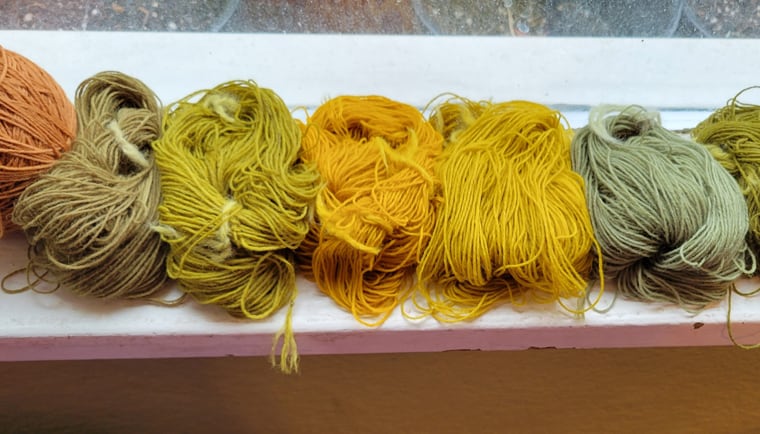
Preserve the Color of Your Gardens Through Natural Dyes
By Jennifer Eddleman, Skagit County WSU Extension Master Gardener
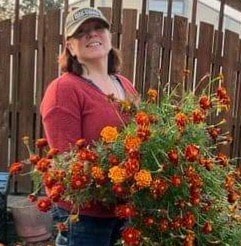
As the summer blooms fade and the bright hues of autumn give way to the gray of November, gardeners and crafters alike find themselves looking for ways to brighten their days. One way to retain some seasonal color is to grow and create your own natural dyes. Whether you’re a knitter, a quilter, a crafter, or you just want some fun kids’ projects – homemade watercolors or Playdough, or naturally-dyed Easter eggs for instance - natural materials provide an endless array of magical color options.
The basics: dyestuffs, mordants and modifiers
Sources of natural dyes are everywhere: in flowers, leaves, roots, bark, berries, fruits, and vegetables. Plants provide the dyestuff. The dye bath is created by cooking or soaking the dyestuff and then straining the solution. The amount of plant material used, and the simmering and soaking time will determine the depth of color. Washing fibers, in a process called scouring, readies them for the dyeing process. Because colors from natural dye sources can be somewhat less colorfast than modern synthetic options, they benefit from the help of mordants and modifiers when dyeing fibers.
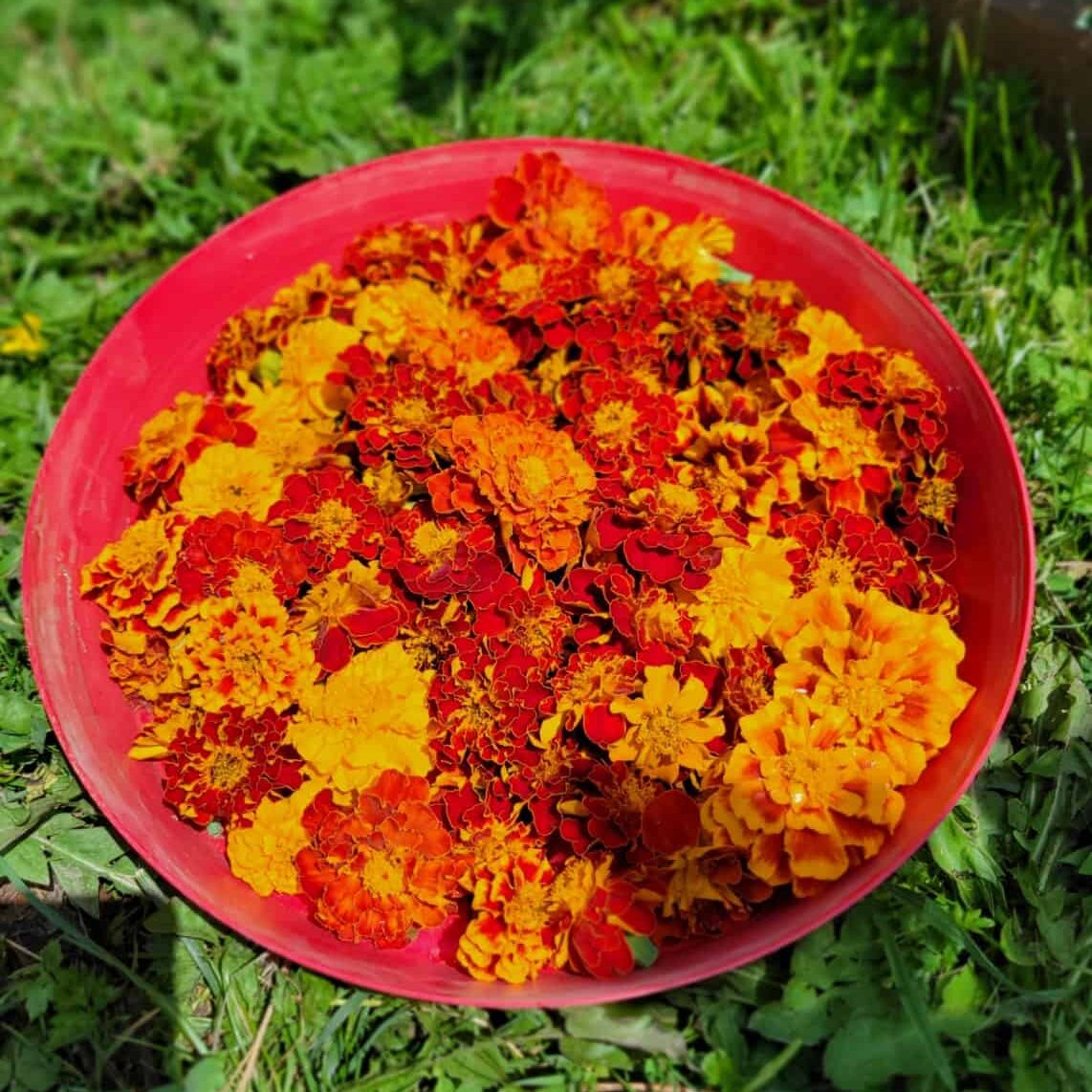
Marigold blossoms are an excellent source of color for natural dyes. Photo by Jennifer Eddleman
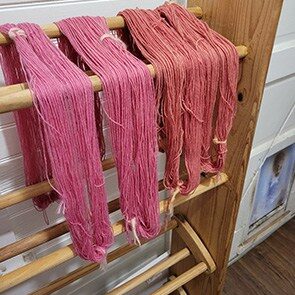
Hopi Red Amaranth Dye yields an array of shades. Photo by Jennifer Eddleman
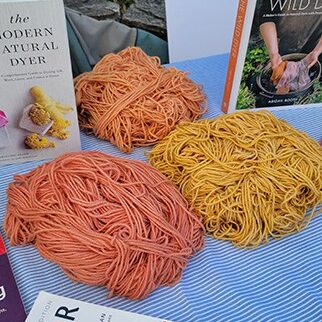
Mordants make a difference in colors. Here, three shades of color are produced by beets manipulated by the choice of mordant. Photo by Jennifer Eddleman
A mordant is a substance that helps bind the color to the fiber to help it last longer and resist fading in sunlight. There are several mordant methods, including soaking your fiber in a mordant solution, adding the mordant directly to the dye bath, or using old aluminum, copper, or iron pots to impart the mordanting qualities of those metals when you soak your yarn or fabric. Online shops dedicated to the craft of dyeing offer mordants in powder form, and you can also create them yourself. Rhubarb leaves, normally discarded because they are inedible, can be cooked down for a mordant that also imparts a yellowish hue to the colors you’re creating, and bark from trees such as cedar can be soaked for a tannin mordant. Aluminum sulfate, used on animal fibers (wool, silk, mohair, alpaca, etc.) happens to be the main ingredient in baking powder, which many people already have on hand.
Modifiers, used before or after dyeing a fiber, can completely change the color of a particular dyestuff. Baking soda and vinegar make excellent inexpensive and effective modifiers by adjusting the acidity level of the dye. Red cabbage makes a great example. Cooking down shredded red cabbage leaves yields an excellent dye bath. Adding vinegar will create a pink or lavender-colored dye, while the addition of baking soda yields blue! Making black bean soup? Soak the dried black beans for 24 hours before cooking and save the soaking water. Vinegar and baking soda will have the same effect as red cabbage dye.
Growing your own dye:
Starting a dye garden can be as simple as adding a few extra plants to an already-established bed. If you’re a vegetable gardener, you have excellent low-commitment opportunities. Beets, red cabbage, and marigolds are common additions to the garden and are excellent dyestuffs. Onion skins are one of the best sources of natural dye. Red onions and yellow onions produce different colors, so consider growing both. Sunflowers make great supports for pole beans, so consider growing Hopi Black Dye sunflowers in your garden and planting black beans around the base. Rhubarb leaves, as mentioned before, are good for mordant, and the roots can be used for dye. This makes rhubarb a multi-purpose plant. If you have fruit trees the bark and leaves of your pear, plum, and cherry trees can be utilized for dyestuff, giving you a use for the trimmings when you prune your trees. Berries can be juiced down and used to create pinks, purples and blues, but be aware that they are “fugitive” dyes, meaning they may fade easily to a grayish color over time and mordants are especially important.
Your existing landscaping may already include dye plants. Heather, Hibiscus, sumac, juniper, Eucalyptus, Oregon grape and willow shrubs, bracken ferns, birch trees, and more are common landscape plants that are also known as dye sources. Flowers you may already be growing, like dahlias, hollyhocks, and daffodils, are useful. Choose the brightest, most color-rich blossoms at the early height of their bloom for the best results. Some annuals that are easy to grow from seed and fit nicely into flower beds include Calendula, marigold, safflower, and amaranth. One variety specifically grown for natural dye purposes is Hopi Red Dye amaranth. If you decide to sow seed or add starts to your existing flower beds, be sure to check your seed packets or tags for the mature size of your plants and allow enough room for them to grow to their potential.
You may choose to create a garden specifically dedicated to growing dye plants. In addition to the landscape shrubs and flowers mentioned previously there are many perennial herbs, flowers and shrubs that will come back yearly and make great anchor plants- madder, agrimony, and goldenrod for example. Leave room for annuals such as those mentioned before, as well as indigo and blue butterfly pea flowers.
Getting started
A quick online search or trip to your local library will yield a plethora of books, websites and blogs dedicated to natural dyeing. There are some great resources out there that provide instructions from start to finish, with all you need to know about equipment, processes, variations, growing and foraging for dye plants, and many of them include projects and recipes to give you a place to start. Plan now for next year and have some fun!
Resources:
A Garden to Dye For: How to use plants from the garden to create natural colors for Fabrics and Fibers; Chris McLaughlin
Wild Color: The Complete Guide to Making and Using Natural Dyes; Jenny Dean
The Craft of Natural Dyeing: Glowing Colors from the Plant World; Jenny Dean
Colors from Nature: Growing, Collecting, & Using Natural Dyes; Bobbi A. McRae
The Wild Dyer: A Maker’s Guide to Natural Dyes with Projects to Create and Stitch; Abigail Booth
The Complete Guide to Natural Dyeing: Techniques and Recipes for Dyeing Fabrics, Yarns, and Fibers at Home; Eva Lambert & Tracy Kendall
Questions about home gardening or becoming a master gardener, may be directed to: WSU Skagit County Extension Office, 11768 Westar Lane, Suite A, Burlington, WA 98233; by phone: 360-428-4270; or via the website: www.skagit.wsu.edu/mg
Washington State University Extension helps people develop leadership skills and use research-based knowledge to improve economic status and quality of life. Cooperating agencies: Washington State University, U.S. Department of Agriculture, and Skagit County. Extension programs and policies are available to all without discrimination. To request disability accommodations contact us at least ten days in advance.
Jennifer; this is a wonderful article! It inspires me to grow dye plants! Thank you for this primer!
I was inspired by Jenn’s article too. Now is a great time to plan for potential dye plants this fall.